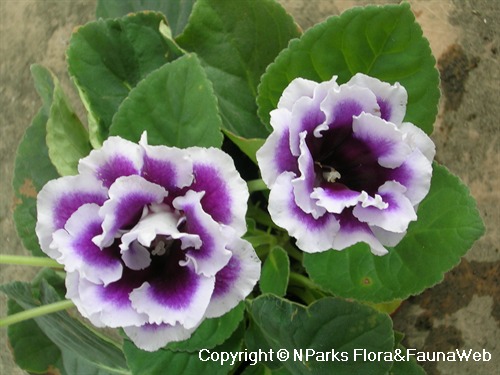
Name
Classifications and Characteristics
| Plant Growth Form | Shrub |
|---|
Biogeography
| Native Distribution | Of horticultural origin |
|---|---|
| Preferred Climate Zone | Tropical, Sub-Tropical / Monsoonal |
Description and Ethnobotany
| Growth Form | Tuberous herbs to 20cm tall |
|---|---|
| Foliage | Leaves dark green above, 8-20cm long by 5-12cm wide, hairy, ovate - elliptic. |
| Flowers | Flowers large, to 10cm across; corolla usually 6-8 lobed in single flowered forms, lobes variable in double-flowered forms. Color of flowers variable, in shades of purple, lavender, red, white and pink, petals and corolla in some forms spotted, or with other patterns. |
Landscaping Features
| Desirable Plant Features | Ornamental Flowers |
|---|---|
| Landscape Uses | Small Gardens, Interiorscape/ Indoor Plant, Container Planting |
Fauna, Pollination and Dispersal
| Seed or Spore Dispersal | Abiotic |
|---|
Plant Care and Propagation
| Light Preference | Semi-Shade |
|---|---|
| Water Preference | Moderate Water, [Remarks] (Do not allow plants to stand in soggy soil as the tubers will rot) |
| Rootzone Tolerance | Well-Drained Soils, Fertile Loamy Soils, Low Humidity / Aircon, Easy to Grow |
| Pest(s) | Sucking Insects |
| Propagation Method | Seed, Leaf Cutting, Storage Organ (Tuberous Stem) |
Foliar
| Mature Foliage Colour(s) | Green |
|---|---|
| Mature Foliage Texture(s) | Hairy / Hirsute |
| Leaf Area Index (LAI) for Green Plot Ratio | 4.5 (Shrub & Groundcover - Dicot) |
Floral (Angiosperm)
| Flower Colour(s) | Red, Purple, White, Yellow / Golden |
|---|---|
| Flower Texture(s) | Thin |
| Flower Grouping | Cluster / Inflorescence |
Fruit, Seed and Spore
| Mature Seed Colour(s) | Brown |
|---|
Image Repository
Others
| Master ID | 1164 |
|---|---|
| Species ID | 2457 |
| Flora Disclaimer | The information in this website has been compiled from reliable sources, such as reference works on medicinal plants. It is not a substitute for medical advice or treatment and NParks does not purport to provide any medical advice. Readers should always consult his/her physician before using or consuming a plant for medicinal purposes. |









.jpg)